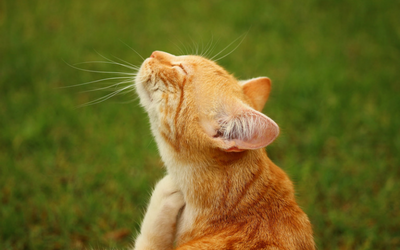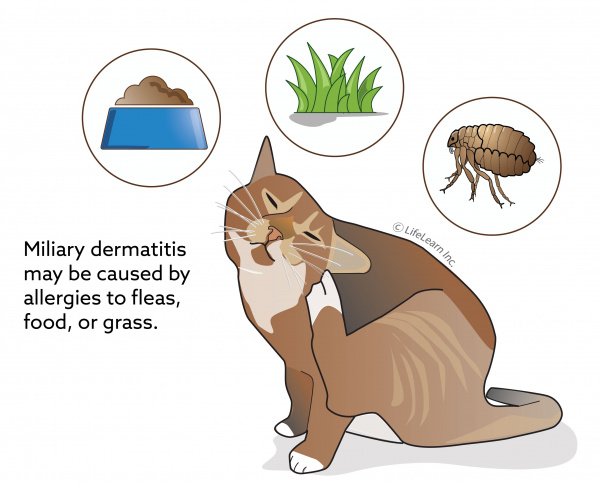Miliary Dermatitis in Cats
What is feline miliary dermatitis?
Feline miliary dermatitis is a general term used to describe a skin condition in cats that most commonly results from an allergic reaction. The term 'miliary' is derived from the word milium, which is Latin for 'millet', as the small crusted lesions of miliary dermatitis resemble millet seeds. Frequently these lesions can be felt rather than seen.
"In some cases, even touching the affected skin causes the cat to scratch, lick, or twitch."
Clinically, the patient has a very itchy rash and may lick, bite, and scratch at the affected skin. In some cases, even touching the affected skin causes the cat to scratch, lick, or twitch. The rash quickly progresses to small lesions with scabs on them; these may be the result of self-trauma, or the result of the allergic reaction itself. The most commonly affected areas include: lower spine and around the base of the tail, face, ears, neck, flanks, and belly. The coat often becomes thin in affected areas. In severe cases, the rash becomes infected, which is seen as pustules or pimple-like lesions. Affected cats spend a lot of time grooming and scratching the affected areas.
What causes miliary dermatitis?
By far the most common cause of feline miliary dermatitis is an allergy to fleabites. Some cats become extremely sensitive to fleabites and a single bite may be enough to provoke quite a severe skin reaction (see handout "Flea Allergy Dermatitis in Cats" and "Flea Control in Cats".
Miliary dermatitis can also indicate an allergy to something in the cat's diet (food allergy dermatitis) or a response to an inhaled allergen (see handouts “Inhalant Allergies (Atopy) in Cats” and “Food Allergies in Cats” for more information on these allergies). Contact dermatitis or contact allergies are another possibility, but this is rare in cats. Miliary dermatitis may also be associated with mites, lice, nutritional deficiencies, and infectious and immune-mediated diseases.
How is miliary dermatitis diagnosed?
Diagnosis is based primarily on medical history and clinical signs. If fleas or flea dirt are observed, or if the cat is not on a flea preventive, the diagnosis may be presumed as flea allergy. If another cause is suspected or if the condition does not respond to symptomatic flea treatment, skin scrapings, biopsies, allergy tests, a hypoallergenic food trial, or a referral to a veterinary dermatologist may be recommended.
How is miliary dermatitis treated?
Treatment involves removing the offending irritant or allergen and reducing the cat's clinical signs. A flea preventive is applied if flea allergy dermatitis is suspected. Live fleas are seldom seen on cats, due to their fastidious grooming habits.
"Corticosteroids are given to make the cat feel more comfortable and reduce the constant itching."
Medicated baths or sprays may be used in cases of parasite infection such as mites or lice. A hypoallergenic food trial is recommended in cases suspected of having a food allergy as a component of the allergy. Your veterinarian may prescribe a short course of anti-inflammatory drugs such as corticosteroids to make the cat feel more comfortable and reduce the constant itching while the specific treatment takes effect. Other treatments may include antihistamines, essential fatty acids, and cyclosporine (brand name Atopica®).
What is the prognosis for a cat diagnosed with miliary dermatitis?
For most cats, the prognosis is excellent for controlling the condition. The offending allergen must be removed for long-term resolution. Depending on the climate and the cat's life style, year-round monthly flea preventive may be recommended. Many cats that have an allergic cause to their miliary dermatitis respond well to intermittent corticosteroid therapy, hypoallergenic diets, antihistamines and/or cyclosporines. Your veterinarian will outline the best treatment protocol for your cat's individual needs.






